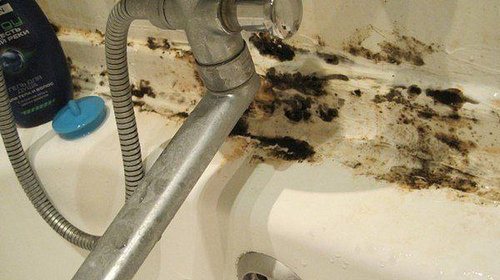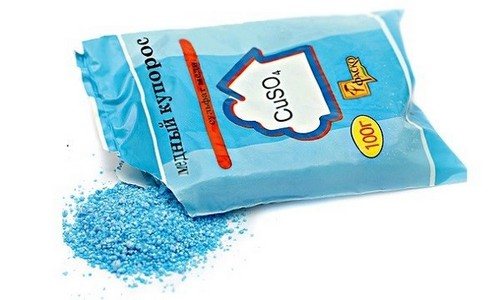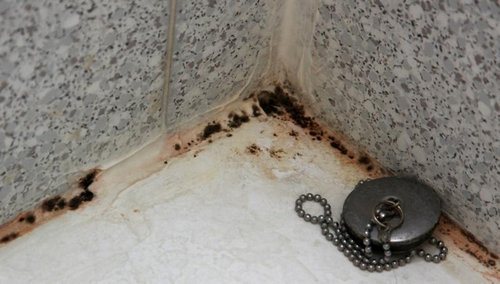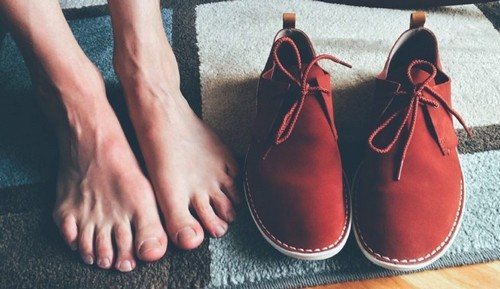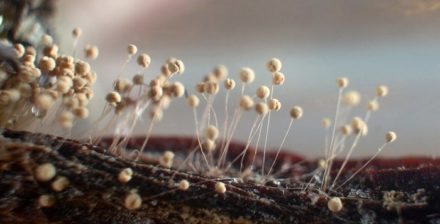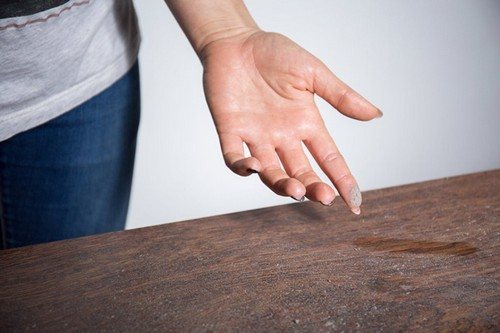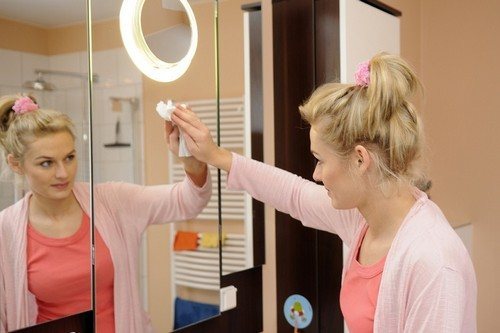Mold on wallpaper can ruin the interior and microclimate of the room, and harm the health of those living in the house. A major overhaul will help eliminate the problem as quickly as possible. But there are a sufficient number of less radical, but effective ways to eliminate the sources of mold colonies.
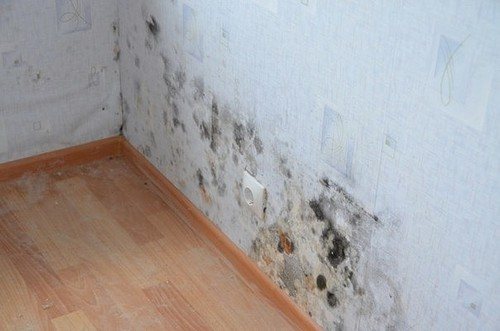
- What is mold and its harm to humans
- Causes of appearance
- Mold under wallpaper after renovation
- First steps
- How to stop the spread
- Tools
- Mandatory protective equipment
- How to detect mold under wallpaper
- How to deal with large-scale pollution
- Removing wallpaper
- Mechanical cleaning of walls
- Treating walls with construction chemicals against fungus
- Subsequent treatment of walls with antiseptics
- Puttying walls and gluing wallpaper
- How to remove local manifestations of mold
- Folk remedies
- Shop products
- How to remove mold without tearing off wallpaper
- Paper wallpaper
- Non-woven, acrylic, washable, vinyl wallpaper
- When you can’t cope on your own
- What to do to prevent mold from appearing again
What is mold and its harm to humans
Mold is a colony of toxic unicellular fungi. Their spores are extremely dangerous to human life and health. When they enter a favorable environment (optimal conditions: lack of light, oxygen supply, high humidity), the spores multiply very quickly, enter the human body by air, causing:
- a sharp deterioration in general health;
- constant headaches;
- development of acute allergic reactions;
- decreased human immunity;
- the appearance of diseases of the respiratory system.
Pregnant women, young children and people with weakened immune systems are most at risk.
Reasons for appearance
Factors contributing to the development of mold fungi:
- High humidity.
- Lack of ventilation. The lack of fresh air flow (hermetically sealed windows) creates a favorable environment for the development of pathogenic microorganisms.
- Furniture moved close to the walls disrupts natural air circulation.
- Lack of insulation (sharp temperature difference in the wall). Violations of the construction process, insufficient waterproofing of floors (and sometimes its complete absence) lead to sharp temperature changes in the wall in the autumn-winter period, which has a beneficial effect on the proliferation of mold fungi.
- The influence of dampness from the basement or poor insulation on the roof. For residents of the first and last floors of apartment buildings, the problem of mold is known. This is because leaking floors, roofs, and damp basements are an ideal environment (damp and dark) for the growth of mold fungi.
Mold under wallpaper after renovation
There are several reasons why mold fungi appear immediately after repairs:
- Use of low-quality, already contaminated building materials. Most often these are sheets of plasterboard, the layered structure of which perfectly preserves pathogenic microorganisms.
- Installation of super-tight metal-plastic window blocks.
- Mistakes made by craftsmen during repairs.So, by gluing new wallpaper onto damp plaster or putty, after a while you can find fresh traces of mold on the decorative wall.
First actions
Having discovered foci of mold fungi, the cause of their appearance is initially eliminated. To this end:
- provide a flow of fresh air;
- adjust the humidity level;
- study the issue of waterproofing the walls of the house, if necessary, carry out insulation work.
How to stop the spread
You can stop the development of mold colonies:
- saturating the room with sunlight and air;
- installing a forced ventilation system;
- providing an influx of warm, dry air (temperature 20-23C). Electric heating devices will come to the rescue;
- Having eliminated sources of dampness, carry out wet cleaning more often using antibacterial drugs.
Tools
Having previously prepared all the necessary equipment, the work of cleaning the walls will proceed quickly and as efficiently as possible.
For work you will need:
- bucket for 10-15 l;
- plastic spray bottles;
- individual protection means;
- hard brush;
- putty knife;
- brush or roller;
- old rags (rags);
- antiseptic drugs.
Mandatory protective equipment
When treating surfaces with antibacterial drugs, it is very important to use personal protective equipment:
- specialized clothing (robe, overalls);
- respirator (protects the respiratory system);
- special glasses;
- latex gloves.
When cleaning walls, ceilings, and floors, it is important to ensure that the room is well ventilated. It is necessary to avoid contact of antiseptics and antifungal drugs with the skin. After finishing work, be sure to take a shower.
How to detect mold under wallpaper
Mold colonies appear very quickly. The first signs that fungal spores are growing under the wallpaper will be small black spots on the surface. Most often, they can be seen in the corners, on the wall behind the furniture.
In the room where mold fungi develop, there is a rather persistent, very unpleasant smell of mustiness, dampness. When entering, it feels like you are entering a basement.
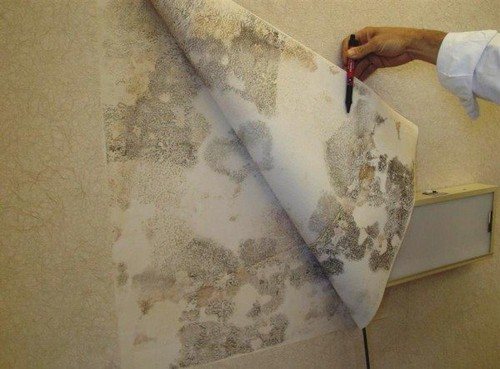
How to deal with large-scale contamination
When mold has grown not only into the wallpaper, but also into the plaster layer, following a clear algorithm of actions will help eliminate the problem.
Removing wallpaper
Ruthlessly tear off contaminated coatings. If fungi have grown into a layer of plaster, hopes that black spots from the wallpaper can be removed with a damp cloth are in vain. Mechanical cleaning of walls
Using a spatula, remove the layer of plaster under those parts of the decorative coating that have been infected.
Treatment of walls with construction chemicals against fungus
A fairly wide range of anti-mold preparations is available to the consumer (Fitoline, Xiolat). Having chosen the most suitable composition, the product is diluted with water according to the manufacturer's instructions and the affected areas of the decorative coating are treated. Experts recommend re-treating no earlier than six hours after the first.
Follow-up treatment of walls with antiseptics
At the end of treatment with an antifungal solution, the wallpaper is additionally coated with special antiseptic agents. They are available to the consumer in a large assortment, and there is no need to dilute them. The antiseptic prevents the appearance of fungus.
Puttying walls and gluing wallpaperMold colonies appear very quickly. The first signs that fungal spores are growing under the wallpaper will be small black spots on the surface. Most often they can be seen in corners, on the wall behind furniture.
Fungus in the bathroom - causes, consequences and solutions
In the room where mold fungi develop, there is a rather persistent, very unpleasant smell of mustiness and dampness. Upon entering, you feel like you are entering a basement.
- How to deal with large-scale pollution
- When mold has grown not only into the wallpaper, but also into the layer of plaster, following a clear algorithm of actions will help eliminate the problem.
- Removing wallpaper
- Rip off contaminated coverings ruthlessly. If fungi have grown into the layer of plaster, hopes that black stains from the wallpaper can be removed with a damp cloth are in vain.
- Mechanical cleaning of walls
- Using a spatula, remove the layer of plaster under those parts of the decorative coating that have become infected.
There is a fairly wide selection of anti-mold drugs available to the consumer (Fitoline, Xiolate). Having chosen the most suitable composition for yourself, the product is diluted with water according to the manufacturer’s instructions and the affected areas of the decorative coating are treated. Experts recommend re-treatment no earlier than six hours after the first.
Subsequent treatment of walls with antiseptics
- Upon completion of treatment with an antifungal solution, the wallpaper is additionally coated with special antiseptic agents. They are presented to the consumer in a large assortment, and there is no need to breed them. An antiseptic prevents the appearance of fungus.
- Puttying walls and wallpapering
- After the dark mold spots have been removed, you can begin decorating the surface. First, it is treated with a finishing putty, and then pasted over with new wallpaper.
- How to remove local manifestations of mold
- You can quickly and effectively remove localized mold foci by following a clear algorithm of actions:
- Determine the location of the mold.
- Wipe the infected area of the wallpaper with a damp sponge.
- Treat the dark spots with hydrogen peroxide or a diluted solution of vinegar.
- Dry the treated area of the wallpaper very well.
- Wet clean the room, treat the infected area with an ultraviolet lamp.
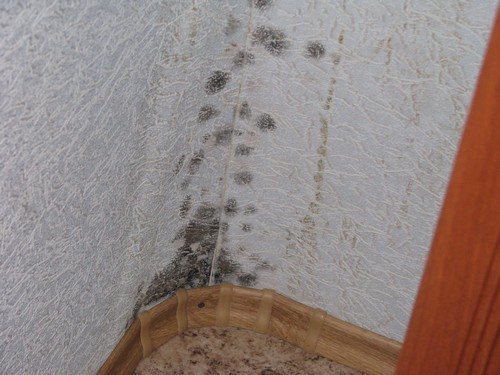
Getting rid of mold in the bathroom forever
Folk remedies
- There are a sufficient number of folk remedies that help quickly remove the fungus:
- Copper sulfate. To treat the damaged area, prepare a solution at the rate of 5 liters of water, 50 g of copper sulfate. Mix the resulting solution thoroughly, and very carefully treat the surface area infected with mold with a roller.
- Chlorine-based bleaches. The main, active ingredient of the bleach - sodium hydrochloride is the worst enemy, a killer for mold spores. Important: chlorine is a highly toxic substance. Work with bleach can only be done in a well-ventilated area, using personal protective equipment (gloves, respirator). For processing, use a solution prepared at the rate of five liters of water, half a liter of bleach. The product is applied with a roller or a stiff brush.
- Laundry soap is effective when the fungus is just starting to grow.To treat damaged areas, rub a bar of soap and dissolve it in 10 liters of warm water. A strong soap solution is applied to the wall and allowed to dry thoroughly. The treatment is repeated several times.
- Vinegar is a non-toxic remedy for fighting mold spores. Vinegar is sprayed onto the wall, and then the loose layer of mold is scraped off with a spatula. It is necessary to wear a respirator when working with vinegar, as its smell is very strong and unpleasant.
Baking soda combined with vinegar gives an excellent result for combating mold damage. Soda is diluted with vinegar to form a paste or slurry. The resulting product is used to treat the required area until the black spots disappear.
Borax (also known as sodium tetraborate) is non-toxic and most effective for combating mold. To prepare the product, dissolve a glass of borax powder in three liters of water. The solution is applied to the surface with a stiff brush, simultaneously removing the visible black layer of fungus.
Hydrogen peroxide is an effective, non-toxic drug in the fight against mold. Peroxide is applied without diluting to the damaged area and left until completely dry. The treatment is repeated several times. Attention: hydrogen peroxide whitens surfaces well. Do not use it on unstable painted surfaces
Tea tree oil has unique antibacterial and antifungal properties. Dissolve a few drops of tea tree oil in 250 ml of water. The resulting mixture is sprayed onto the stain.
A UV lamp is effective for the initial manifestations of mold infection, as well as for prevention purposes. The treatment time for the damaged area is 10-15 minutes.
Mold on apartment walls and copper sulfate as an effective antifungal agent
Store products
Top most effective store-bought anti-mold medications:
Dali (Russia). Available in 5 liter containers. The product is intended for treating any surface. Dali is a universal remedy, effective not only against mold fungi, but also against moss and other manifestations of dampness.
Fongiflud Alpa (Russia) is produced in containers of 2, 5, 20 liters. The product is intended for treating surfaces against fungus inside the house, from the facade. The drug retains its antiseptic properties even at low temperatures.
Olympus stop mold (Russia) is an ideal remedy for fungus and mold spores affecting the surfaces of bathrooms, living quarters, basements, cellars. The product is suitable for treating any surface.
Biotol spray is an environmentally friendly antiseptic. Non-toxic, safe for residential use.
- Ftlas mykos (Poland). The main active ingredient is ammonia. The drug is effective in combating mold spores and perfectly removes damp stains.
- How to remove mold without tearing off wallpaper
- The need to remove wallpaper in order to remove mold is easy to determine. Tear up a small section of the wallpaper and carefully inspect the wall underneath.If the plaster is dry and light-colored, then mold fungi can be removed without removing the wallpaper.
- Dangerous black mold: how to get rid of the uninvited “guest”?
- Wallpaper paper
- Removing mold from paper wallpaper is a labor-intensive and troublesome task. Under no circumstances should they be wet. A soft brush, a hairdryer, and a lot of patience will help remove dark spots.
- Dry the wallpaper and carefully remove the stain with a soft brush.
- Non-woven, acrylic, washable, vinyl wallpaper
- This type of wallpaper is characterized by good resistance to moisture and abrasion. You can clean dark stains from such surfaces using any chemical or folk remedies.
- When you can't handle it on your own
In a situation where time is lost, mold fungi have managed to grow, penetrate the plaster and begin to destroy the brickwork, it will no longer be possible to eliminate the problem on your own. The solution will be major repairs or disinfection carried out by SES specialists.


